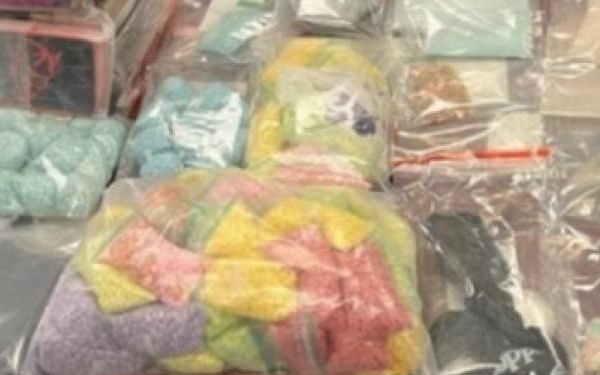Federal agents uncovered what looked like a fentanyl assembly line during a Bronx apartment raid this week. Six Dominican nationals were caught in the act, hunched over workstations like a twisted version of Santa’s workshop—except instead of toys, they were packaging enough lethal powder to kill four million people.
Jesus Javier Brito Rivera, Jose Alexis De La Cruz Mora, Jose Antonio De La Cruz Mora, Dany Rivera Sanchez, Joan Alberto Toribio Tavarez, and Freddys Rivera Quezada were arrested on Tuesday, September 9, 2025, while processing more than eight kilograms of suspected fentanyl powder. Authorities say the mill had been operating for at least a year, generating millions in profits and ranking among the most sophisticated drug operations prosecutors have ever seen.
Inside the apartment, the scene was both orderly and disturbing. Four workstations lit with reading lamps resembled a grim study hall, each surface coated with fentanyl dust. The kitchen oven was repurposed to dry stamped drug packets. Thousands of doses sat packaged and ready for street sale, while others remained unfinished, showing the mill was running at full speed when agents stormed in.
The Bronx Drug Mill Problem
This bust is not an isolated case—it’s part of a troubling trend across the Bronx. DEA records show that just two years ago, agents dismantled another large-scale mill at 1244 Grand Concourse, seizing about 100,000 glassine envelopes filled with fentanyl and heroin. In that case, suspects attempted to evade capture by hiding under solar panels on the roof.
In December 2024, yet another operation was uncovered at 2300 Olinville Avenue—directly across from an elementary school. More than 13 pounds of drug mixtures were seized, and airborne fentanyl powder forced an evacuation of the entire building.
These mills often embed themselves in residential neighborhoods. As DEA Special Agent Frank A. Tarentino explained, the Bronx has become a hub for drug trafficking organizations, exploiting its location to move narcotics along the Northeast corridor—often setting up shop just blocks from schools and homes.
Previous Local Cases
The latest arrests echo the case of Jesus Cabrera, sentenced to 30 years in prison for running a Bronx fentanyl operation tied to at least eight overdose deaths. Cabrera’s group was infamous for stamping packets with logos like “Supreme” and “Off White,” branding deadly drugs like luxury goods.
The six defendants in this case, aged 22 to 45, include individuals who share family names, suggesting possible family ties within the operation. They now face conspiracy and distribution charges, each carrying a maximum penalty of life in prison.
The Disturbing Details
Investigators described the apartment as stocked with trafficking tools. Court records list two boxes containing 17 grinders packed with powder, numerous scales, packaging supplies, colanders, markers, rubber bands, and even MetroCards—used in the processing and packaging of fentanyl.
Most alarming was a drawer full of stamps to brand the drugs with different logos—a marketing tactic that turns lethal substances into “products” recognizable to buyers on the street.
Agents found tables piled with thousands of wrapped and stamped packets, alongside a separate stack of stamped but unsealed ones, confirming the mill was running at full capacity during the raid.
The Bigger Picture
While CDC data showed national overdose deaths dropping nearly 24% in 2024, New York continues battling the fentanyl epidemic. The DEA’s 2025 National Drug Threat Assessment reported more than 60 million fentanyl-laced counterfeit pills and nearly 8,000 pounds of fentanyl powder seized last year—equal to more than 380 million lethal doses.
The timing of this bust—just days before this report—highlights the case’s urgency as legal proceedings move forward. U.S. Attorney Jay Clayton praised the joint operation, stating, “New Yorkers want these mills destroyed and their operators off the streets.”
What Happens Next
The charges carry harsh consequences under federal drug laws. With more than eight kilograms of fentanyl at issue, the defendants face mandatory minimum sentences that could put them in prison for decades. The U.S. Attorney’s Office for the Southern District of New York’s Narcotics Unit, which prioritizes shutting down fentanyl mills, will prosecute the case.
NYPD Commissioner Jessica S. Tisch emphasized the danger, noting, “this staggering amount would have put countless New Yorkers in great danger.” The bust reflects a coordinated strategy involving the DEA, NYPD, New York State Police, and other agencies working together to stop these operations before their product reaches the streets.
For Bronx residents already facing urban struggles, these cases are stark reminders that the fentanyl crisis is not distant—it’s being manufactured inside neighborhood apartments, sometimes just steps from where families live and children go to school.
This article has been carefully fact-checked by our editorial team to ensure accuracy and eliminate any misleading information. We are committed to maintaining the highest standards of integrity in our content.









